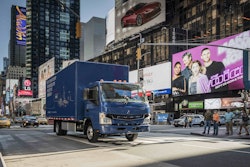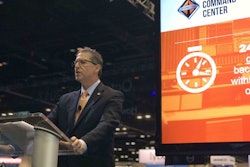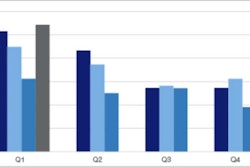 Roger Nielsen, DTNA president and CEO, discusses the company’s efforts for an electric powertrain for the Freightliner Cascadia.
Roger Nielsen, DTNA president and CEO, discusses the company’s efforts for an electric powertrain for the Freightliner Cascadia.As non-traditional players enter the trucking space with promises of electrified powertrains for Class 8 truck applications, Daimler Trucks North America says it too is working on an electrified powertrain for its Freightliner Cascadia tractor.
Last month, Daimler introduced the Fuso eCanter and is now entering production to deliver units to customers in the United States and Japan with an operating range of 60 to 80 miles. In Europe, Daimler’s Urban eTruck has about double the range, still well short of the demands for Class 8 over-the-road applications. As the company leverages battery technology across its global platform, DTNA is working on a heavy-duty electric powertrain solution, said Roger Nielsen, president and CEO of DTNA, at a press briefing in Orlando in conjunction with the American Trucking Association’s 2017 Management Conference & Exhibition.
“We have quite an effort in place to electrify the Cascadia,” said Nielsen. “You will see it rather soon on the road. We believe it is a technology worth exploring, but the industry has a lot to learn about battery-electric vehicles. We need to increase the power density and get rid of the weight penalty and the real cost of ownership makes it about the business case,” adding the focus is on bringing the technology to maturity and depreciation remains a concern if battery life is limited to six or seven years.
Daimler recently invested in StoreDot, an Israeli startup company with expertise in fast-charging lithium-ion battery technology, and Nielsen hinted at an upcoming announcement in its school bus product line. “The use case [for battery technology] in school buses is high on the list,” he said.
Connectivity
As OEMs continue to roll out proprietary truck technologies, the line between equipment maker and connected vehicle solutions provider continues to blur.
“We are not in the connectivity business to supplant fleet management systems,” said Nielsen, referencing a presentation slide that quipped ‘Daimler Trucks is a mobile device company that happens to build trucks and buses.’ “At the core, our connectivity is all about increasing uptime and everything we can do to keep the truck out of our shops and on the road.”
Nielsen does believe the OEM-provided connectivity can play a bigger part in integrating disparate third-party hardware with separate communications systems. “We would like to get it down to where a fleet has only cellular contract to manage,” he added, citing one customer who had 18 separate cellular contracts on equipment inside a truck. “We have capability within our truck data center to put together a software development kit and APIs to allow parties that today put hardware and a cellular connection inside our vehicle to not have to do the cellular connection.”
The OEM-proprietary connectivity that has given rise to remote diagnostics and remote updates with flashing-over-the-air (FOTA) technology has given rise to more fleet control over engine parameters and other vehicle functions. “Some of our creative customers are imagining ways to use FOTA faster than we can.” One example is a fleet incentivizing its drivers to use cruise control by governing the engine to 66 mph with cruise control engaged and 64 mph without cruise control. “That allows the driver to make more money and the fleet owner uses less fuel.”
Active safety
Advanced driver assistance systems (ADAS), such as DTNA’s Detroit Assurance 4.0 that now offers active braking on stationary and moving objects, are reducing driver fatigue and improving fleet safety performance. As additional ADAS features are added to trucks on the path towards autonomous driving, Nielsen said he doesn’t envision truly driverless trucks happening anytime soon.
“The driver does more than just steer, brake and accelerate,” said Nielsen. “He provides a service to the shippers and his fleet, and is doing pre- and post-trip inspections and handling issues that come up on the road.”
Nielsen said DTNA continues its work to refine its platooning solution and is working to develop an active steering/lane-keep assist solution to support its vehicle platooning program, hinting an announcement will be coming sooner than later. When the company’s platooning concept is ready for market, Nielsen said it will remain proprietary to DTNA equipment.
“As we get deeper into our testing and the technology and communication required between the vehicles – especially when you are talking about controlling brakes and steering and accelerators – we don’t believe in ‘promiscuous pairing,’ we definitely believe it is intra-fleet,” said Nielsen. “If two fleets with common equipment would like to pair [into a platoon], we have the technology to open up the devices so that fleet A and fleet B can operate and pair, but definitely not mixed brands.”











